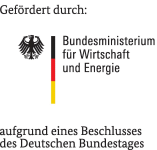The research project pools extensive experience in the design and analysis of modern marine propulsion systems in order to further develop unconventional propeller shapes that deviate significantly from conventional geometry variants. These offer the propeller designer additional design options and aim to achieve improved hydrodynamic characteristics in terms of efficiency and noise emission.

| Title: | Design of efficient ship propellers with unconven-tional shapes SVA: Design of unconventional propellers |
| Term: | 12/2020 – 06/23 |
| Project Manager: | Katrin Hellwig-Rieck |
| Founding: | Federal Ministry for Economic Affairs and Energy |
| Project administration: | Project Management Jülich |
| Partners: | MMG, TUHH, Friendship Systems AG, HSVA, Uni Rostock, ISA Propulsion GmbH & Co. KG |
| Reg.-No.: | 03SX516E |
The aim of the sub-project EukonPro of SVA Potsdam is the development of design strategies for unconventional propellers. Based on the work of SVA with the software PanMare, a complete design will be developed and at the same time the methods of PanMare and the HYKOPS module will be further developed in cooperation with the TUHH.
Compared to previous unconventional designs, the module developed in HYKOPS provides SVA’s propeller designers with further degrees of freedom in the arrangement of the profiles in space. This enables new design strategies to be discovered and evaluated. SVA Potsdam supports the development work by performing model tests and numerical simulations. The evaluation of the efficiency of different unconventional propeller designs of the research partners is carried out on the model of a twin-screw ship. As expected, the conversion methods of the propeller characteristics from the model to the full-scale version developed for conventional propellers are not easily applicable to unconventional propellers. Therefore, numerical investigations of scale effects and laminar-turbulent transition are also carried out on unconventional propeller geometries. Numerical calculations are carried out to support the analysis of full-scale measurements of the velocity in front of and behind the propeller.
In this project various numerical methods for prediction are to be applied to unconventional propeller shapes and evaluated with regard to their efficiency and analysis accuracy in order to develop them further. In addition to the knowledge gained from the application of numerical methods, the experimental investigation of selected propeller geometries will ensure the validity of the numerical calculations. Due to the consideration of propeller geometries at the limits of the technical possibilities, allow the conclusion that designs with more common shapes can also be reproduced.